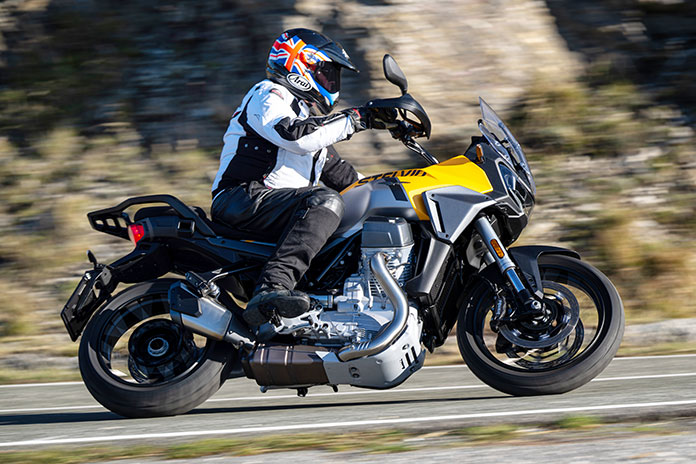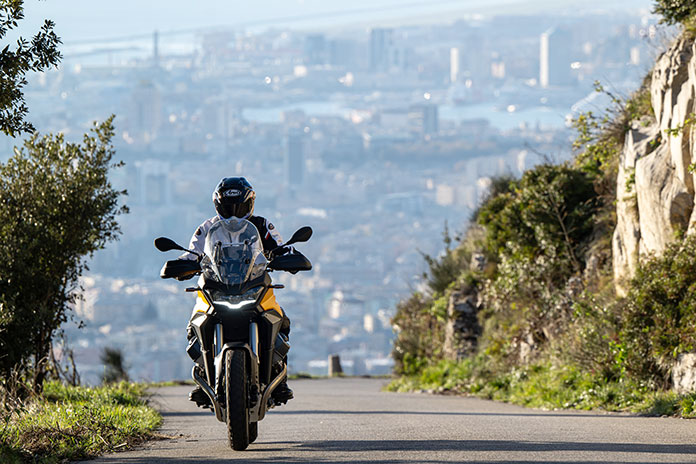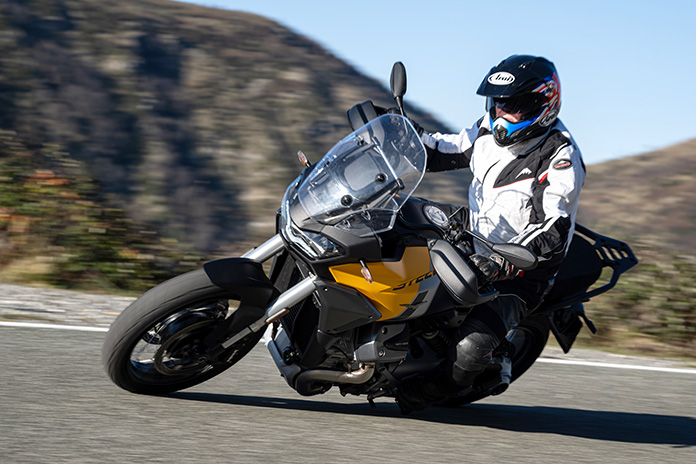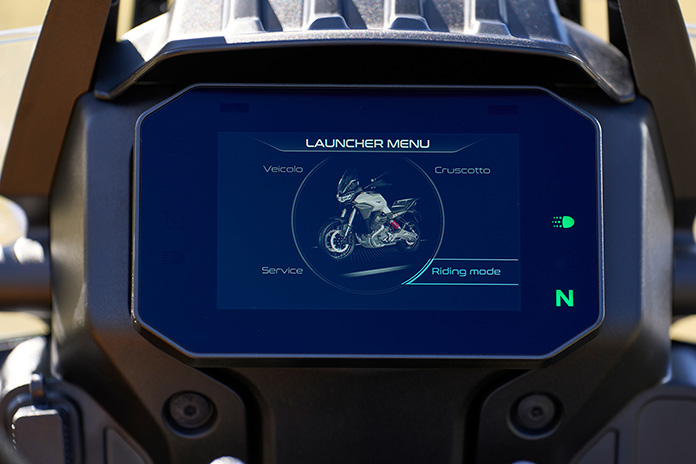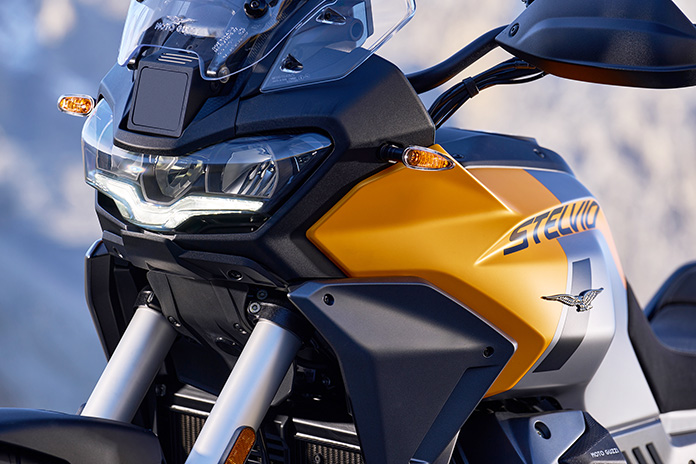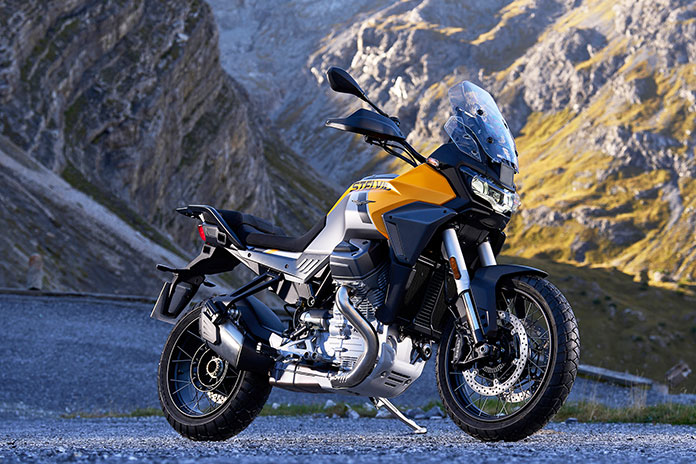In continuous production since 1921, Moto Guzzi is Italy’s oldest motorcycle manufacturer. Covid forced a one-year postponement of the 100th anniversary celebrations held at its Mandello del Lario factory on the shores of Lake Como, but Guzzi is now making up for lost time.
Last year, Moto Guzzi launched the first bike based on its newest model platform: the multifaceted V100 Mandello, which aspires to be both an urban roadster and a mile-eating sport-tourer. One year later comes another new model, the reimagined 2024 Moto Guzzi Stelvio adventure-tourer, which was designed and engineered alongside the V100 and unveiled at last November’s EICMA show in Milan.
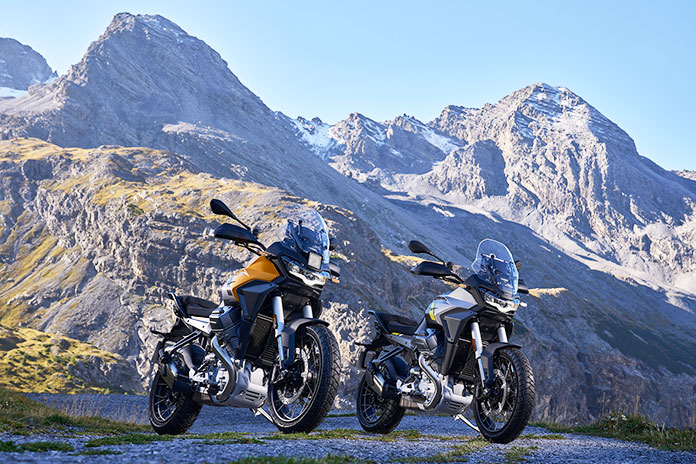
Given the current significance of the ADV segment in global market terms, it’s surprising that Guzzi’s owner, Piaggio, didn’t prioritize the Stelvio over the Mandello, but hey, better late than never. As I soon understood on an exclusive ride aboard this new model along the fabulously scenic, super grippy, and ultra-demanding mountain roads of the Ligurian Alps north of Genoa on a sunny winter’s day, this is a significant new model that moves Moto Guzzi to the forefront of everyday motorcycling.
Priced at $16,390 without the optional PFF Rider Assistance package, this new Guzzi is more costly than Suzuki’s $14,849 V-Strom 1050XT, Honda’s $14,499 Africa Twin, and Husqvarna’s $14,899 Norden 901.
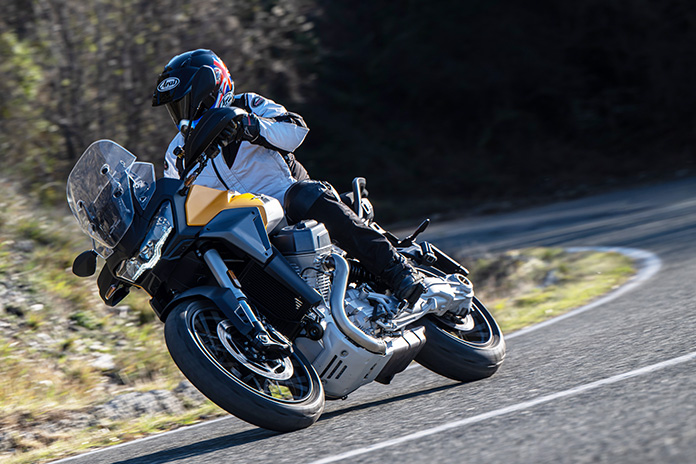
Named after the legendary Dolomites pass in northern Italy, which connects two valleys via 48 hairpin bends, the Moto Guzzi Stelvio is a reincarnation of the previous model bearing the same name, which debuted in 2007 but was shelved in 2016 since it was unable to meet Euro 4 compliance. Powered by Guzzi’s 1200/8V Big Block motor, the previous iteration of the Stelvio was a much larger and 66-lb heavier motorcycle than its modern counterpart, and it represented an Italian air-cooled V-Twin alternative for those who didn’t want to ride a BMW R 1200 GS.
Related: 2012 Moto Guzzi Stelvio NTX | Road Test Review
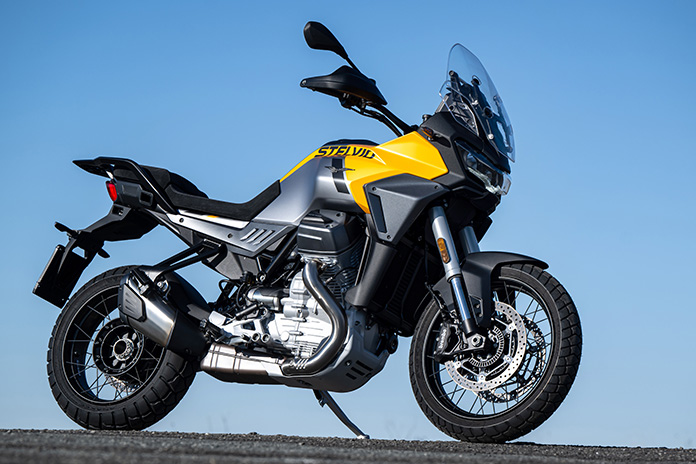
The new Stelvio is a very different package, which, like the V100 Mandello, ticks an array of new boxes for the historic Italian brand. It’s Moto Guzzi’s first liquid-cooled ADV, its first with a DOHC valvetrain, its first to be fitted with a gear-driven counterbalancer, and its first to embrace advanced electronics, including a 6-axis Continental IMU to provide data for the throttle-by-wire, cornering ABS, and other digital amenities. It’s a second long-awaited 21st century real-world Moto Guzzi model, which Piaggio’s late boss Roberto Colaninno had promised he’d bankroll for the past decade or more. His engineers finally delivered it to the marketplace after his August 2023 passing.
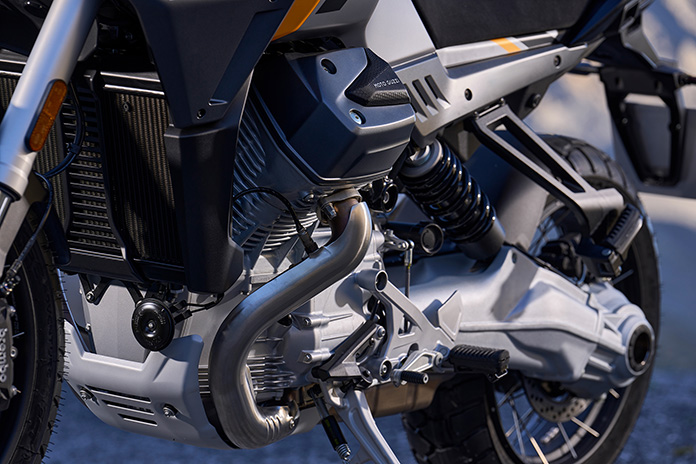
The result is a completely modern yet totally individual motorcycle that could not have emanated from any other manufacturer. Designer Giulio Rossi Paccani sought to create a best-in-class machine, one that wouldn’t need the famous Eagle badge or the trademark “flying” V-Twin to be identified as a Guzzi. The new Stelvio has undoubted presence – it looks classy, sleek, and undeniably modern, with the DRL light strip beneath its headlamp incorporating the silhouette of the Eagle in the Moto Guzzi tank badge with its wings spread wide. That’s neat!
Climb aboard the 32.7-inch stepped seat, which is sufficiently padded and has ample space for a passenger, and you’ll discover a great riding position thanks to the wide, tapered alloy handlebar that’s mounted on tall 3.7-inch risers and falls naturally to hand. The rubber grips are fat and thick, just right for good purchase. The new Moto Guzzi Stelvio feels more accessible than some other ADV models because the rider sits in it rather than perched up high, adding to the sense of control even in tricky conditions. This is a confidence-inspiring motorcycle that I felt at one with from the start. At 5-foot-10, I could put both feet flat on the ground at traffic lights thanks to the seat’s narrow front. Lower and taller seats are available as accessories.
The resulting riding stance is quite upright, with the rubber-mounted footpegs positioned relatively far back but not enough to be uncomfortable or to push the rider’s knees far enough forward to make friends with the cylinders, a common problem with Guzzi’s older OHV air-cooled V-Twins. Despite the fatter cylinders and heads of this liquid-cooled DOHC 8-valve motor, my knees came nowhere near the engine thanks also to the cylinders being inclined forward 6 degrees from vertical to create extra space, having already been rotated 90 degrees so that the throttle bodies are now positioned under the fuel tank, which also helps free up space. The engine is a fully stressed member of the tubular-steel trellis frame with eight mounting points.
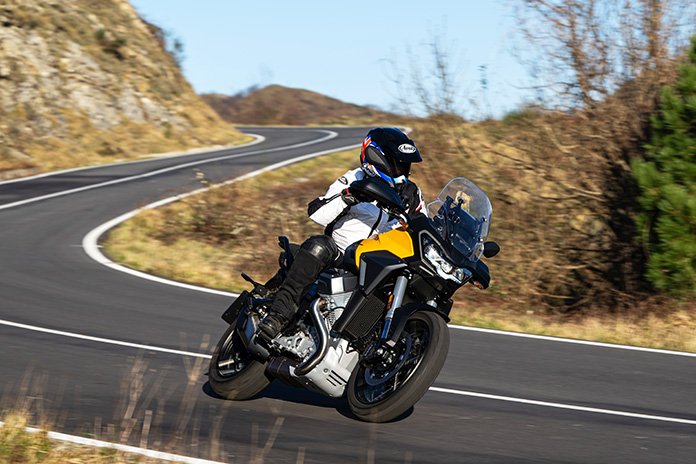
Thumb the starter button, and the Stelvio’s V100 motor bursts immediately into life, settling to a 1,300-rpm idle without any trace of the rock ‘n’ roll from side to side delivered by traditional air-cooled Guzzis like the V85TT, which remains in production as a counterpoint to the Stelvio. Even if the throttle is blipped in neutral, there’s hardly any sway. It’s also nearly silent mechanically, with no sign of the clicks and rattles of its pushrod ancestors.
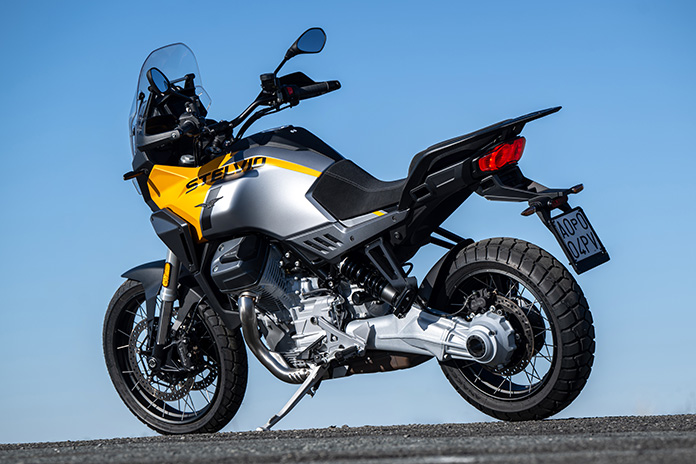
This is a totally modern motorcycle, which also doesn’t rise and fall on the suspension when you put it in gear and ride away or when you roll on and off the throttle because of the shaft final drive’s hypoid rear drive unit. Guzzi engineers have finally delivered the best of both worlds that was always there for the taking if only they’d addressed this sooner – the convenience and cleanliness of shaft drive coupled with the neutral dynamics of a chain-drive bike. Lots of good engineering has gone into this motorcycle.
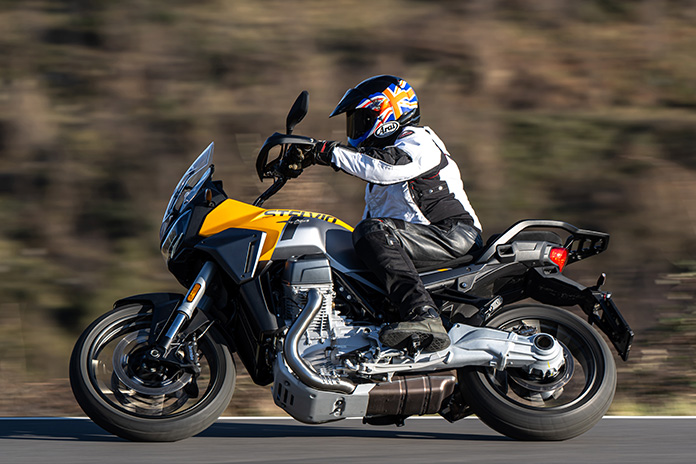
The clutch lever is a bit stiffer than the one mated to the old air-cooled motor – but working said lever in traffic-choked stretches of road didn’t tire out my left hand unduly. The 6-speed gearbox’s shift action was almost flawless, and though not fitted to the Stelvio I tested, an up/down quickshifter is available as an option.
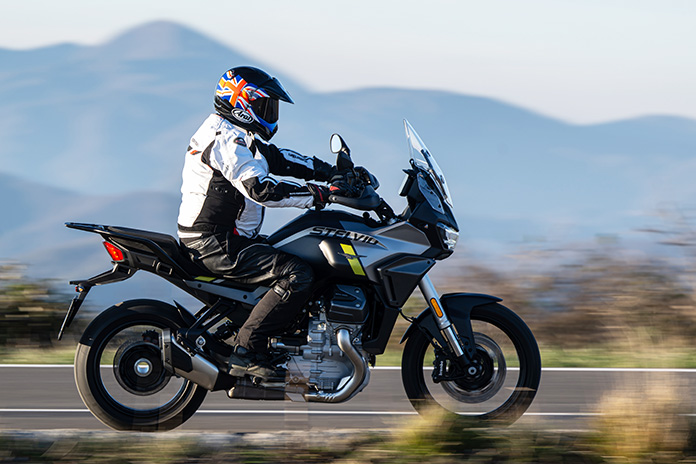
The Stelvio’s engine picks up strongly from 2,800 rpm upwards, with 3,000-6,500 rpm being the happy zone where riders will surf most of the time. It’s a wonderfully flexible motor, and 3rd gear especially is a useful ratio that you can hold for miles on end along a winding hillside road, running from as low as 2,000 revs to the 9,500 rpm soft-action limiter with zero transmission snatch and an utterly linear torque curve.
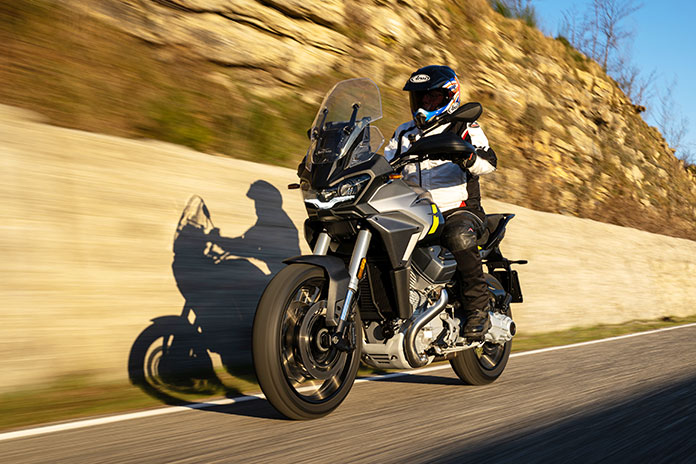
Thanks to the counterbalancer, there’s no real vibration to speak of, so you can really push the Stelvio hard, using the excellent feedback from the Sachs fork and the fine grip of the front Michelin Anakee Adventure tire to start sparking the footpegs’ hero tabs as you flick it from side to side. This is a nice-handling bike, with an unexpectedly plush ride quality, and despite its lack of a progressive-rate link, I could feel the KYB rear suspension smoothly working away beneath me. The suspension is adjustable for rebound damping and spring preload front and rear, and travel is 6.7 inches at both ends.
The Stelvio’s five ride modes (Sport, Road, Touring, Rain, Off-Road) all deliver full power, claimed to be 115 hp at 8,700 rpm and 77.4 lb-ft delivered at 6,750 rpm when measured at the crank, but they are tailored to different conditions using three different engine maps, three levels of engine braking, four levels of traction control, and two ABS modes.
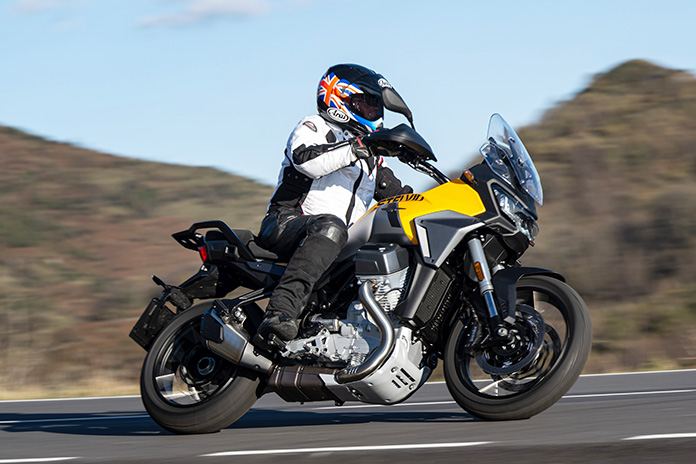
Road and Touring modes are very similar in response – whereas Sport is notably crisper and more exciting to use – but they all make the Stelvio easy and responsive to ride, and it’s very easy to switch between them on the go via a button on the right switchblock. Cruise control is also standard. The fact that most of the bike’s development was accomplished in the Aprilia R&D Center in Noale, Italy, is surely one reason the Stelvio’s electronics are so excellent.
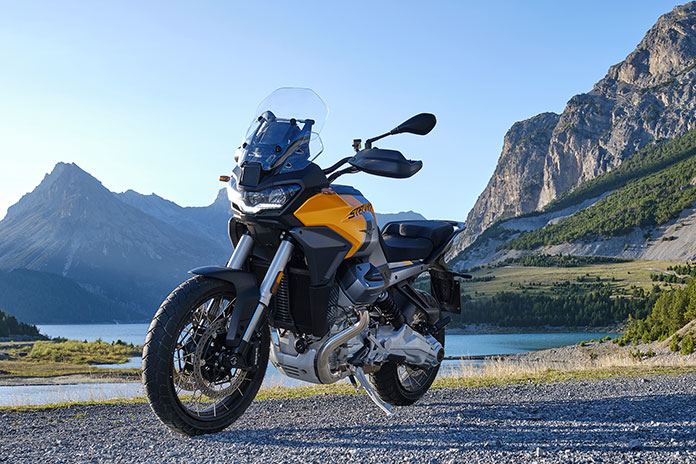
Although the bike I tested was not so equipped, the Stelvio will be the first model available with Moto Guzzi’s PFF Rider Assistance Solution as a factory-installed option. It uses 4D Imaging Radar technology to enable several safety-related features, including Following Cruise Control, Forward Collision Warning, Blind Spot Information System, and Lane Change Assist. Pricing for this option has not yet been announced.
The Stelvio has crisp, neutral steering and is surprisingly agile, with its wide handlebar allowing you to easily lever the bike from side to side through a series of twisting turns leading into yet another 2nd-gear hairpin while remaining super stable when needed, especially under hard braking. Indeed, slowing for such turns via the excellent Brembo brakes, with good initial bite from the radial monoblock front calipers, is always effective, and I could trail-brake into the apex without the Guzzi wanting to stand up and understeer.
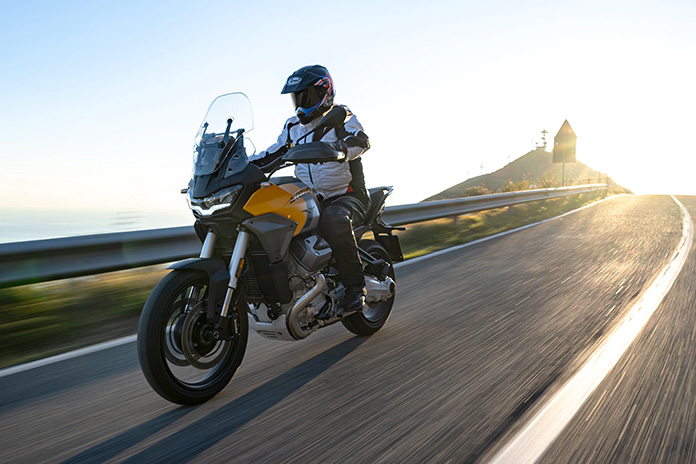
The bike’s steering geometry (25.6-degree rake and 4.6 inches of trail), rational 59.8-inch wheelbase, and 170/60-17 rear tire all contribute to sweet, intuitive steering without having to give a discernible tug to the handlebar to make it change direction quickly. The 19-inch front tire suits the bike’s likely use: I didn’t get the chance to ride it off-road, but this is what the Italians call a moto strade bianche – a motorcycle that tackles the country’s network of white gravel roads with aplomb. But Guzzi insiders dismiss any thoughts of a 21-inch front wheel for more serious off-roading: “It’s not in our plans,” says Piaggio PR Manager Fabio Gilardenghi.
One reason for the sweet steering is the Stelvio’s balance – it’s not just a pretty face, but a rational real-world ride too, with well-chosen stock suspension settings so that it doesn’t pitch back and forth unduly during hard braking and acceleration. The wind tunnel-developed electrically adjustable windscreen adds comfort on long, fast stretches thanks to its 2.8-inch range of height adjustment, as well as the effectiveness of the small side flaps that deflected the breeze off my shoulders. In the lowest position, airflow over the screen came at my helmet’s chin, but there was no buffeting. With the screen fully raised, protection was impressive, delivering a calm bubble of mostly still air.
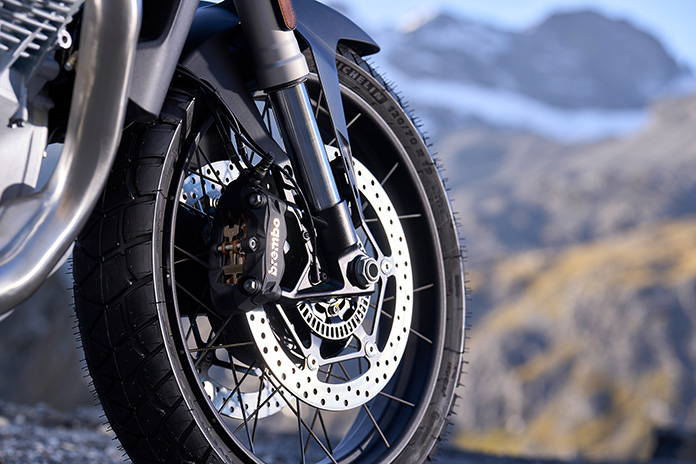
However, the Stelvio’s 5-inch color TFT dash is parked obtrusively in your line of sight, and while you eventually get used to the location, it looks rather unsightly and impacts visibility unless you sit fully upright in the seat. Having said that, the dash is both packed with data and super legible – the central digital speedo and the gear indicator to its right are very easy to see, as is the set of menus for configuring ride modes, controlling amenities, and linking to a smartphone. Navigating the menu system is both simple and intuitive.
My day’s ride around Liguria on the new Stelvio was certainly fun but frustratingly short, as it was just a brief taster of what may very well be the best Moto Guzzi roadbike yet made – one which will appeal to conquest customers from rival brands, as well as diehard guzzisti. If you think I’m overstating the case, go and book a test ride at an event or your local Moto Guzzi dealer and then tell me I’m wrong. Piaggio’s marketing team knows they need to make the bike available for potential purchasers to try out to have any chance of convincing them of the Stelvio’s excellence. Even more than the Mandello, this is a well-engineered step forward into a brave new world for Moto Guzzi, which has achieved modernity without sacrificing its traditional qualities and intrinsic customer appeal that were derived from its neo-vintage range of previous models.
The build quality is very high, just as the prices are. And this is just the beginning, for after the Mandello and the Stelvio, there’s apparently a whole series of variants using the same platform already lined up to be launched at the rate of one new model every year for the next few years. After decades of riding Moto Guzzi models that never troubled the competition in a direct shootout but whose deficiencies you were prepared to excuse on the grounds of “character” or “tradition,” it’s good to see Piaggio has finally come up with the goods by underwriting the development of a potentially class-leading contender in the midsize ADV sector, one of the most competitive segments of today’s two-wheeled marketplace.
See all of Rider‘s Moto Guzzi coverage here.
2024 Moto Guzzi Stelvio Specs
- Base Price: $16,390
- Website: MotoGuzzi.com
- Warranty: 2 yrs., unltd. miles
- Engine Type: Liquid-cooled, longitudinal V-Twin, DOHC w/ 4 valves per cyl.
- Displacement: 1,042cc
- Bore x Stroke: 96 x 72mm
- Horsepower: 115 hp @ 8,700 rpm (factory claim)
- Torque: 77.4 lb-ft @ 6,750 rpm (factory claim)
- Transmission: 6-speed, hydraulically actuated slip/assist wet clutch
- Final Drive: Shaft
- Wheelbase: 59.8 in.
- Rake/Trail: 25.6 degrees/4.6 in.
- Seat Height: 32.7 in.
- Wet Weight: 542 lb (90% fuel)
- Fuel Capacity: 5.5 gal.
Check out more new bikes in Rider’s 2024 Motorcycle Buyers Guide
The post 2024 Moto Guzzi Stelvio Review | First Ride appeared first on Rider Magazine.
Source: RiderMagazine.com

